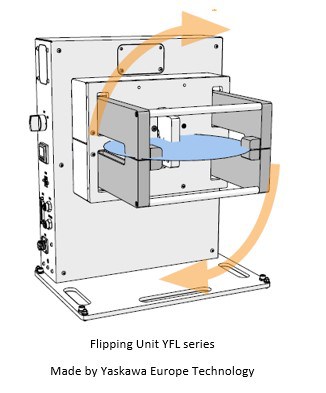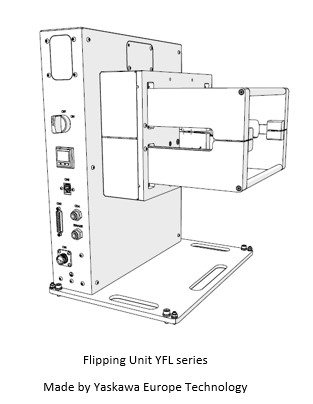As part of the semiconductors manufacturing process, in some cases, there is a need to flip the semiconductor substrates. This flipping procedure is typically required in the following cases:
Bonding – as part of this process, two wafers are bonded together. The process requires flipping one of the wafers so that the backsides of the two wafers can be bonded.
- De-bonding – in this case, two bonded wafers are separated. This process involves flipping the de-bonded wafer back to its original state.
Backside contamination inspection – to identify contaminations, sometimes there is a need to perform additional inspections on the backside of the wafer. This process involves flipping the wafer to expose its backside for inspection.
- And more
The flipping process is usually done after the substrate has been etched on one of the sides before it is flipped, which means that the process is extremely sensitive. Even the introduction of a nano-meter sized impurity may void the wafer. Also, any tiny damage to the wafer itself, such as a tiny crack, which may be unnoticeable to the naked eye, can also completely void the silicon wafer.
There are two main methods that are used to flip semiconductor wafers:
-
- Integrated Flipping – in this method the wafer handling robot arm itself performs the flipping. This is typically achieved by adding a wrist to the robot and/or by adding additional direction/movement capabilities to the servo and robotic arm.
- Yaskawa Dedicated External Flipping Unit – this method uses a dedicated flipping unit that is placed within the enclosure. The wafer handling robot inserts the wafer into the flipping unit. The wafer is flipped 180 degrees within the flipping unit and then the robot collects the wafer again. Following the processing, the wafer is inserted into the flipping unit again and flipped back to its original position and thereafter it is placed back in the wafer cassette.
The following paragraph compares the two methods in various aspects:
1. Space requirements
Integrated Flipping - Although the flipping is handled by the robot itself without requiring space for an additional unit, in practice it is extremely important to allocate a dedicated spherical space within the enclosure for the flipping process. This space must be free from any obstacles to ensure the safety of the process and to ensure that the wafer is not damaged.
Yaskawa Dedicated External Flipping Unit (YFL series) - The dedicated flipping unit requires a dedicated space within the enclosure. The flipping unit is located in a suitable location determined in the preliminary design process
2. Complexity
Integrated Flipping - One of the main drawbacks of this method is the added complexity that is introduced to the robot. Such a solution may involve adding additional electrical or pneumatic components to an already crowded enclosure. The additional processes add considerable complexity to the existing complicated and sensitive robotic process.
Yaskawa Dedicated External Flipping Unit (YFL series) - The dedicated solution does not add complexity to the sensitive robotic process. There is simply a need for periodic maintenance and calibration.
3. Single point of failure
Integrated Flipping - The additional complexity that is introduced adds additional potential fault/failure points and, since this is an integrated process, if a fault/failure occurs, it may disrupt the entire production process.
Yaskawa Dedicated External Flipping Unit (YFL series) -As an external dedicated solution, if there is a fault, the robotic process may continue without the flipping process. And if required, the flipping unit can be easily replaced in its entirety without causing substantial disruptions.
4. Robot cost and repurposing
Integrated Flipping -Without getting into specific cost comparisons, it is clear that you would need a high-end sophisticated robot to perform the additional flipping process and this costly robot cannot be repurposed to serve regular processes that do not require flipping.
Yaskawa Dedicated External Flipping Unit (YFL series) - The flipping unit can be combined with any robot, including standard robots. These robots can be seamlessly repurposed to other processes that do not require flipping.
5. Gripping flexibility
Integrated Flipping - The entire process of handling and flipping must be done using the same gripping method – either edge gripping or vacuum gripping, as two gripping methods cannot be combined on the same robot. Since the flipping process typically requires edge gripping, which prevents contamination of the etched side, this means that when using the integrated flipping method, it will not be possible to use the vacuum grip at all, preventing the support of vacuum grip applications/use cases.
Yaskawa Dedicated External Flipping Unit (YFL series) -The handling process can use one gripping method (edge or vacuum), while the flipping can use another gripping method (typically edge gripping), allowing greater flexibility and the ability to accommodate any need.
6. Size versatility
Integrated Flipping - Supports a single size only. It is very complicated to change the components to support other sizes. This means that multi-sized production lines are not possible using this method.
Yaskawa Dedicated External Flipping Unit (YFL series) - Some flipping units are able to seamlessly support multiple sizes without intervention or replacement of parts.
7. Safety
Integrated Flipping - Adding safety features to avoid damage or faults, is inherently more complex and costly when integrated on the robot itself.
Yaskawa Dedicated External Flipping Unit (YFL series) - The dedicated flipping unit features sensors that safeguard the process and prevent damage to the wafer. These features focus on the flipping process and do not require adding additional complexity to the handling process.
Conclusion
As demonstrated above, the dedicated flipping unit is a simpler, more reliable, and safer way to perform semiconductor wafer flipping as offered by Yaskawa YFL product series. Integrating the flipping capabilities to the robot itself creates a single point of failure, which may disrupt all production processes (even those that do not require flipping) when there is a fault. In addition, processes that require multiple gripping methods (edge gripping and vacuum gripping) cannot be supported by the integrated gripping solution and can only be supported by the dedicated flipping unit solution. Moreover, some dedicated flipping units can be used in multi-sized production lines that require seamless transition between multiple wafer sizes.



